Fannie Mae’s August housing forecast calls for a higher level of multifamily housing starts in 2024 than predicted in last month’s forecast. This is the second month in a row where the forecast for multifamily starts has been revised higher. However, the forecast for single-family housing starts was revised lower through the end of 2025. Single-family starts are still expected to trend downward in 2024 and then to rise through the end of 2025.
Fannie Mae’s forecasters are predicting more aggressive rate cutting by the Federal Reserve than in last month’s forecast. They still expect the Fed Funds rate to end the year 2024 at 5.0 percent. However, the forecasters are now expecting the Fed Funds rate to fall to 3.8 percent by the end of 2025. Last month’s forecast predicted that the rate would drop to only 4.3 percent by then, so they are now predicting 6 quarter-point rate cuts by the end of 2025.
The 10-year Treasury is reported to have risen to 4.4 percent in Q2 2024. It is now predicted to drop to 4.1 percent in Q3 2024 and to also end the year 2025 at that level. This rate is about a quarter point lower than the rate predicted in last month’s outlook.
Improved forecast for multifamily starts
The current forecast for multifamily housing starts is shown in the first chart, below, along with three other recent forecasts. Fannie Mae considers any building containing more than one dwelling unit to be “multifamily”, including both condominiums and rental housing units.
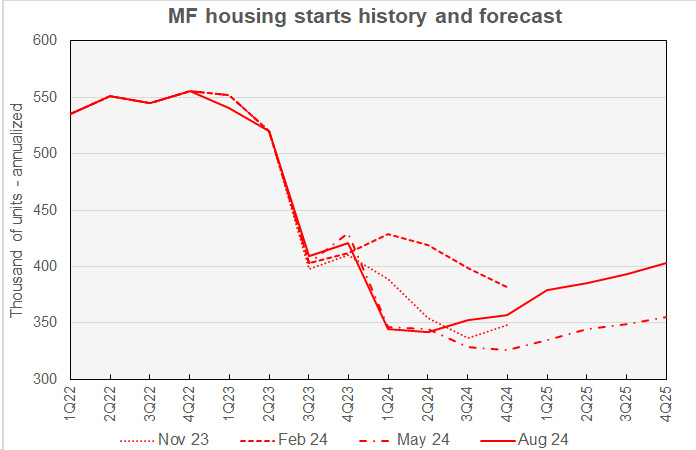
Fannie Mae’s forecasters revised their multifamily housing starts forecasts higher this month over their entire forecast horizon, with the exception of a small downward revision to the forecast for Q3 2024. The low point for multifamily starts is still seen as being in Q2 2024, but the forecast number of starts for that quarter was raised by 10,000 annualized units to 342,000 annualized units.
For reference, the most recent new residential construction report from the Census Bureau has multifamily starts running at an annualized rate of 334,000 units in Q2 2024, although revisions to the data are possible.
Fannie Mae’s current forecast calls for multifamily starts to rise, starting in Q3 2024 and continuing through the end of 2025, finishing 2025 at a rate of 403,000 annualized units. This is 33,000 annualized units higher than in last month’s forecast.
Looking at yearly forecasts, the predicted number of multifamily starts for 2024 was revised higher by 5,000 units to 349,000 units. The forecast for multifamily starts in 2025 was revised higher by 28,000 units to 390,000 units.
Single-family starts forecast revised lower again
The current forecast for single-family housing starts is shown in the next chart, below, along with three other recent forecasts.
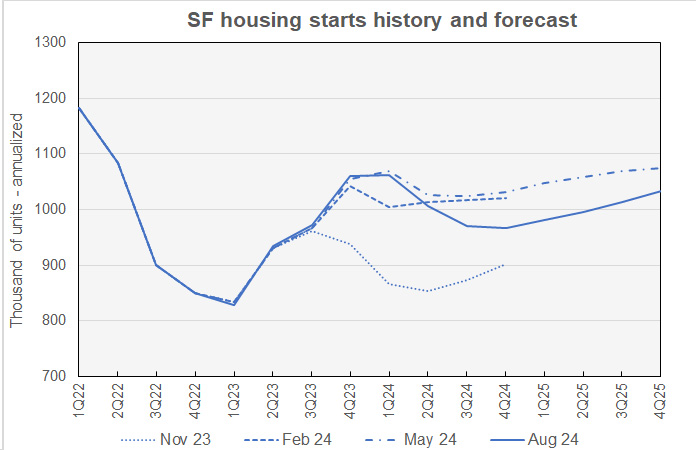
In the current forecast, each quarterly prediction for single-family starts from Q3 2024 through the end of 2025 was lower than in last month’s forecast. The Q3 2024 forecast was revised lower by 25,000 annualized units. The forecasts for the following quarters were revised lower by 12,000 to 20,000 annualized units.
The low point for single-family starts is still expected to be in Q4 2024. The annualized number of single-family starts expected in that quarter is 967,000. Single-family starts are then forecast to rise gradually, reaching 1,033,000 annualized units in Q4 2025.
Looking at their full-year predictions, Fannie Mae now expects single-family starts to be 1,001,000 units in 2024, down 9,000 units from the level forecast last month. Single-family starts in 2025 are forecast to be 1,006,000 units, down 16,000 units from the level forecast last month.
GDP growth outlook revised higher for 2024
The next chart, below, shows Fannie Mae’s current forecast for Gross Domestic Product (GDP) growth, along with other recent forecasts.
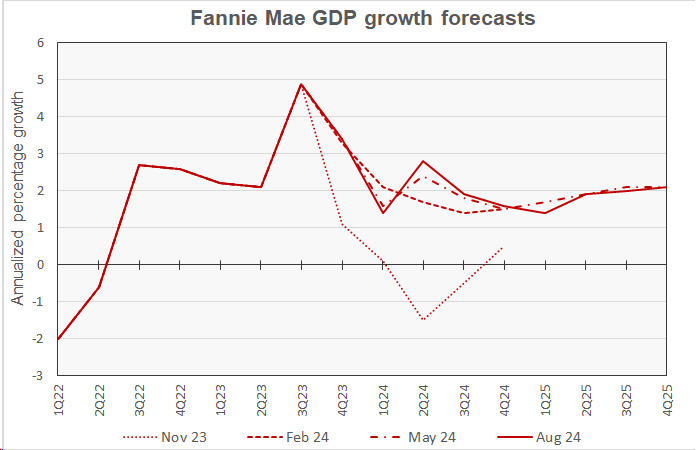
As happened last year, the August forecast for Q2 GDP growth was revised significantly higher, rising 0.9 percentage points to 2.8 percent at a seasonally adjusted annualized rate. This is in line with the advance estimate for Q2 GDP from the Bureau of Economic Analysis. Fannie Mae’s forecasters also made two other significant revisions to their quarterly GDP forecasts. They raised their forecast for Q3 2024 higher by 0.5 percentage points to 1.9 percent and they revised their forecast for Q1 2025 lower by 0.4 percentage points to 1.4 percent. Other revisions were at most 0.1 percentage points.
The full year forecast for GDP growth for 2024 was raised 0.3 percentage points to 1.9 percent while the full-year forecast for 2025 was lowered 0.2 percentage points to 1.8 percent.
Lower CPI Inflation predicted
The next chart, below, shows Fannie Mae’s current forecast for the Consumer Price Index (CPI), along with three other recent forecasts.
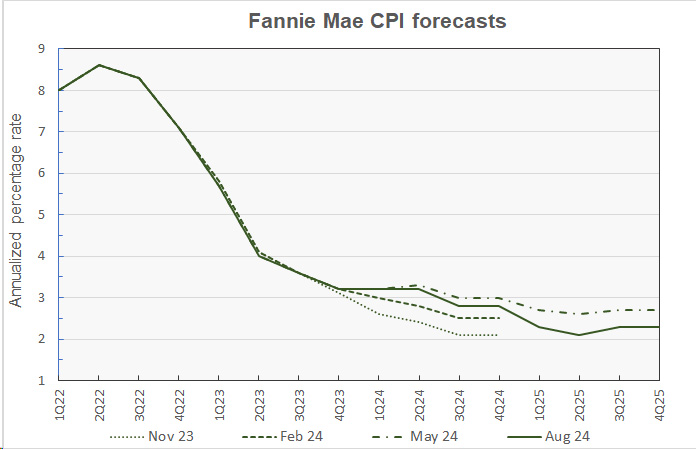
Again this month, all revisions to Fannie Mae’s CPI inflation quarterly forecasts were to the downside. Inflation was predicted to be 0.1 percentage point lower in Q3 and Q4 2024. It was predicted to be 0.3 percentage points lower in Q1 2025 and it was predicted to be 0.4 percentage points lower in Q2, Q3 and Q4 2025.
Looking at whole-year forecasts, the prediction for year-over-year CPI inflation in Q4 2024 was lowered 0.1 percentage points to 2.8 percent. The Q4 2025 year-over-year inflation forecast was lowered 0.4 percentage points to 2.3 percent.
Employment growth forecast slightly lower
The next chart, below, shows Fannie Mae’s current forecast for employment growth, along with three earlier forecasts. Employment growth is our preferred employment metric since job gains, along with productivity gains, drive economic growth. By contrast, the unemployment rate depends on employment but also on the labor force participation rate. Either rising employment or falling labor force participation can drive the unemployment rate lower, but only the former would contribute to economic growth.
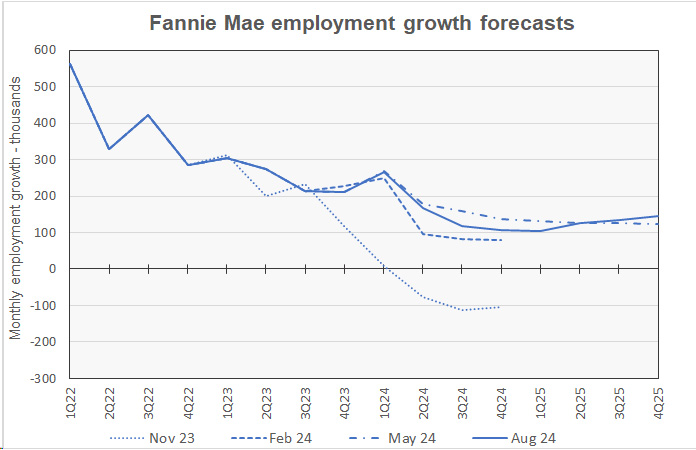
Revisions to this month’s quarterly employment growth forecasts are all to the downside with the exception of that for Q4 2025. Monthly job growth is forecast to fall from Q2 2024’s level of 168,000 jobs per month, reaching 105,000 jobs per month in Q1 2025. It is then forecast to recover, reaching a level of 146,000 jobs per month by Q4 2025.
For reference, the business survey in the Employment Situation Report from the Bureau of Labor Statistics indicates that the economy added an average of 168,000 jobs per month in Q2 2024.
Compared to last month’s forecast, the expected full year forecast for employment growth in 2024 was revised lower by 200,000 jobs while employment growth for 2025 was revised lower by 100,000 jobs. Employment growth in 2024 is expected to be 2,000,000 jobs. Employment growth in 2025 is expected to be 1,500,000 jobs.
The Fannie Mae August forecast can be found here. There are links on that page to the detailed forecasts and to the monthly commentary.













